|
|
 Seed mixes are totally inadequate. Sunflower seeds and peanuts usually cause chronic health problems including Vitamin A deficiency. This can eventually cause respiratory disease, beak, and claw problems, poor plumage, poor skin on feet, runny nose, and swollen eyes. Seed mixes are totally inadequate. Sunflower seeds and peanuts usually cause chronic health problems including Vitamin A deficiency. This can eventually cause respiratory disease, beak, and claw problems, poor plumage, poor skin on feet, runny nose, and swollen eyes.
Parrots on a poor diet often also suffer from calcium deficiency. The birds become quiet and inactive with drooping wings culminating eventually in seizures.
Click here to read more
|
|
|
 This is a smaller member of the parrot family. With its' striking colors and patterns as well as its' ease in taming when kept as a single bird, the lovebird makes an excellent pet. This is a smaller member of the parrot family. With its' striking colors and patterns as well as its' ease in taming when kept as a single bird, the lovebird makes an excellent pet.
They are relatively small in size, averaging about 4 to 5 inches in length. Varieties of the domestic lovebird are: peach-faced, fisher, and masked. The most common is the peach-faced lovebird.
Click here to read more
|
|
|
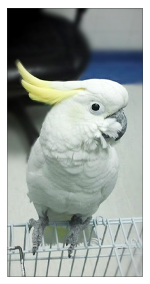
Some Examples Include:
- Daily sessions outside the cage at least three hours a day
- Leave the radio or TV on when out. Silence stresses parrots.
- All pet parrots should be trained in basic obedience, and this should include flight commands. This is essential for your bird's mental well-being and your relationship with the bird.
- Something to look at out of the window will also help, as long as the bird doesn't get terrified by predators. But don't put the cage in direct sunlight through glass it's bad for them.
Click here to read more
|

|
|
|
There are 2 main sub-species of African Grey parrot - the Congo and the Timneh. Congo's are bigger and lighter with a red tail and dark beak. They are approximately 12-14 inches from beak to tail and on average weigh between 400-650 grams. The Timneh are smaller and darker with a maroon tail and a horn coloured upper beak. They measure 9-11 inches from beak to tail and on average weigh between 275-400 grams.
Both species have the potential to live for well over 50 years. The average is usually around 25-50, bear in mind that taking on one of these birds is a lifelong commitment which should not be taken lightly.
Click here to read more
|
|
|
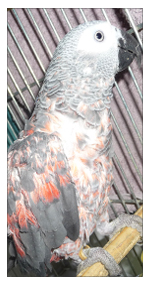 If your parrot starts plucking, do not wait. Take action now. A feather plucking problem can become a chronic habit which is difficult to change. Parrots can end up looking like supermarket chickens if their owners don't move fast. If your parrot starts plucking, do not wait. Take action now. A feather plucking problem can become a chronic habit which is difficult to change. Parrots can end up looking like supermarket chickens if their owners don't move fast.
Feather plucking can be caused by a range of different problems.
Click here to read more
|
|
|
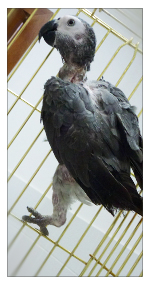 PBFD is caused by a Circovirus. This virus is hardy and can survive in the environment. This makes transmission by inanimate objects possible, as well as direct transmission between birds. PBFD is caused by a Circovirus. This virus is hardy and can survive in the environment. This makes transmission by inanimate objects possible, as well as direct transmission between birds.
The disease can be spread by inhalation or ingestion of feather dust, faeces, and oral secretions of infected birds. Females may pass it through their eggs to their young.
Click here to read more
|
|
|
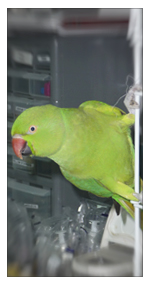 Fast becoming the most widely distributed of all the parakeet species, Ringneck parakeets are well on their way to becoming as popular an avian pet as the budgie. Fast becoming the most widely distributed of all the parakeet species, Ringneck parakeets are well on their way to becoming as popular an avian pet as the budgie.
These two different birds share many of the same traits that make either of them desirable as pets --- they are both hardy birds, easily tamed, learn speech with ease and come in a variety of stunningly beautiful jewelled colors.
Click here to read more
|
|
|
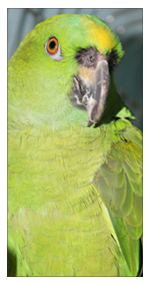 With parrots the most common causes of stress are boredom, inadequate relationship between the bird and its owners, unsuitable caging, anxiety due to the environment, cruelty by owners (usually unintentional). With parrots the most common causes of stress are boredom, inadequate relationship between the bird and its owners, unsuitable caging, anxiety due to the environment, cruelty by owners (usually unintentional).
Well adjusted, properly socialised parrots can cope with a certain amount of stress. It is those birds which are not well socialised and do not have a good relationship with their keepers which are vulnerable to suffering undue stresses.
Click here to read more
|
|
|
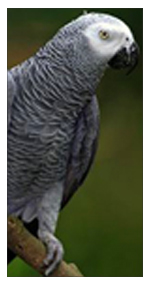 Young hand-fed African grey parrots may start to mumble human sounds at a few weeks of age. Just as wild parrots learn natural vocalizations from their parents, companion parrots learn to imitate human sounds from their "surrogate parents." The first words they learn are usually simple words their owners have repeated often with enthusiasm like 'Hello', 'UP', 'Hi!', or 'Wanna Bite'. Young hand-fed African grey parrots may start to mumble human sounds at a few weeks of age. Just as wild parrots learn natural vocalizations from their parents, companion parrots learn to imitate human sounds from their "surrogate parents." The first words they learn are usually simple words their owners have repeated often with enthusiasm like 'Hello', 'UP', 'Hi!', or 'Wanna Bite'.
Click here to read more
|

